
Mattel is releasing a limited edition Gold Label Barbie David Bowie doll this year. Barbie is dressed as Bowie’s alter ego Ziggy Stardust in this licensed tribute to the iconic musician.
If I had to choose an artist who epitomizes modernity and futurism, I would select David Bowie. My choice certainly isn’t a surprising one, except for two facts. Number one, Bowie is no longer alive; number two, he did groundbreaking, earth-shattering performances a half-century ago! Let that statistic sink in. Yes, David Bowie and his pop epic “Space Oddity” debuted 50 years ago, on July 11, 1969.
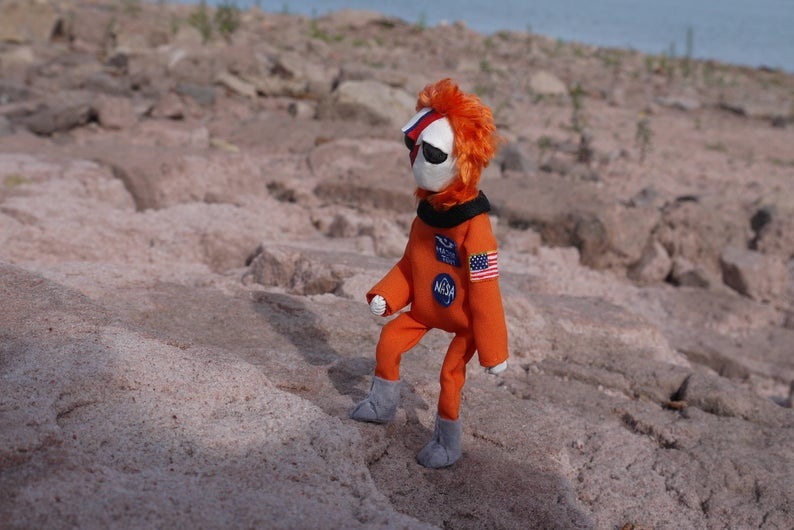
HuskySnail has fashioned an incredible posable version of David Bowie’s iconic Major Tom.
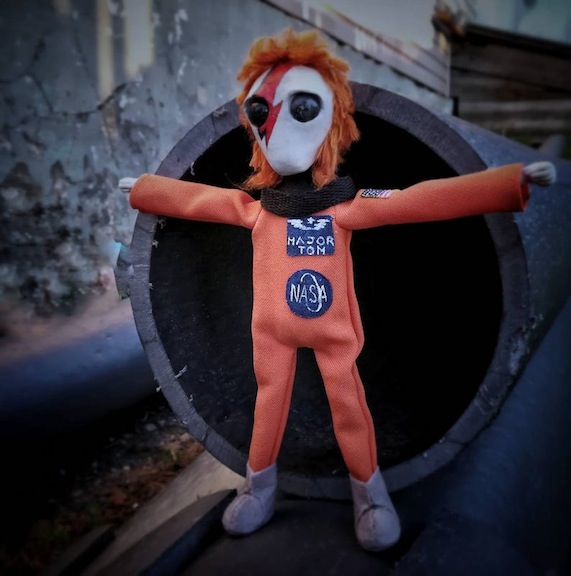
The HuskySnail depiction of Bowie as Major Tom caused a sensation on Etsy.
Blessed with an ability to mine the news for themes and texts, Bowie introduced the world to Major Tom five days ahead of Apollo 11. While 22-year-old David Robert Jones was putting the finishing touches on his David Bowie persona, American engineers were preparing to launch their lunar spaceflight. On June 16, NASA got the green light, and the rest was history. (Or, if you are a conspiracy theorist, the moon landing is cinematic history. It was filmed on a movie set and tapped into Hollywood ingenuity.) Neil Armstrong and Buzz Aldrin got the chance to walk on the moon’s surface, play a round of golf, and plant a flag. The third Apollo 11 member, Michael Collins, had to wait in the command module. Talk about being a left-out third wheel!
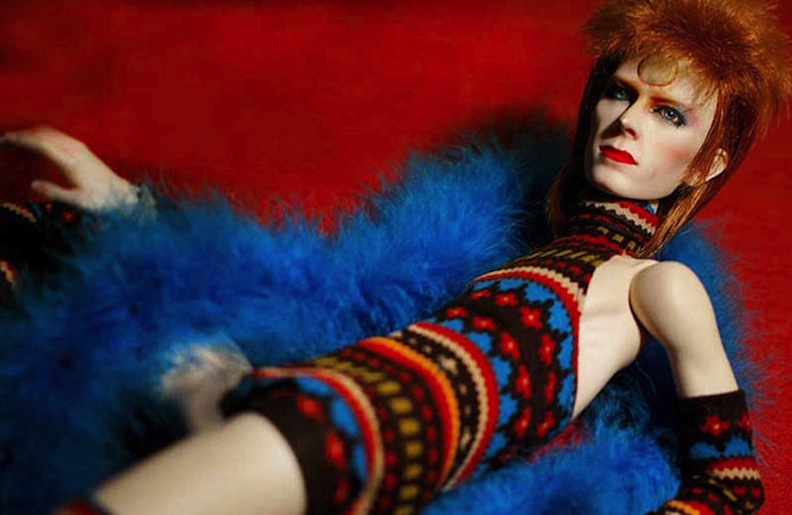
E. V. Svetova, under the artist name Katyok, constructs Bowie dolls. They are not for sale.
It is so strange that the crewcut, clean-shaven, clean-living Apollo astronauts were co-existing with the lanky, long-haired, libertine pop star. Even though Armstrong, Aldrin, and Collins had actually traveled to the heavens, David Bowie appeared as if he belonged there. The NASA vibe was a serious, military-minded attitude. It was a career where service, science, and mathematics were rewarded. Bowie was staying earth-bound in London, but letting his mind do all the journeying. Holed up in his apartment, he was cranking out lyrics that tackled this world and the one beyond.
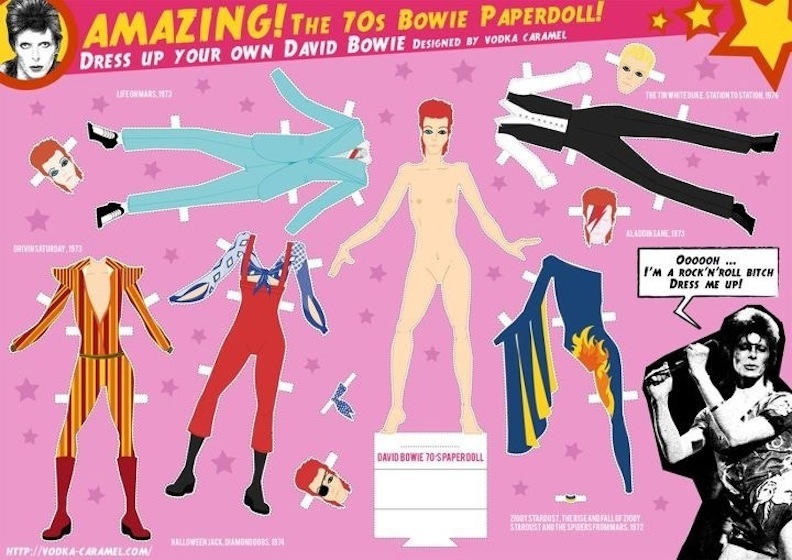
Attracted to the cinema and to space, Bowie inserted himself into the moon race via “Space Oddity.” The eye-popping paper dolls are made by Vodka Caramel.
Bowie’s “Space Oddity” was a cleverly crafted song. Even though he appeared very poetic and exotic, Bowie was also a businessman. He knew that the hot months of 1969 were not just the Summer of Love and Woodstock. He recognized that it was also the culmination of the U.S. space program. Britain’s endeavors were all unmanned, and the public considered them to be dull and “business as usual.” Minus cosmos-traveling dogs, like the Soviet’s Laika, Belka, and Strelka, England’s attempts were just hardware and circuit boards. Boring! The United States was upping Russia by placing men into their capsules and heading them toward the moon. It was mind-blowing, and David Bowie loved the concept.

April Norton has honored Bowie’s legacy and his many incarnations with her portrait doll.
When the traveling art exhibit “David Bowie is” landed in America last year, I very happily attended. It took over the Brooklyn Museum from March 2 to July 15, 2018. When visitors entered the display — wearing state-of-the-art headphones — we were all greeted with a loud swelling of music and the opening lines of “Space Oddity.” We were one with Major Tom, and Bowie’s voice was swirling through our heads. It was an incredible meshing of external visual cues and internal dialogue and melodies. Before he passed away in 2016, Bowie had taped seemingly infinite interviews about his life, motivations, inspirations, and work. His two spouses — ex-wife Angie and widow Iman — provided access to photos, journals, manuscripts, clothing, and all types of ephemera. It was a case of collectibles overload.

Based out of Barcelona, Kutuleras responds to the Bowie legacy: both astronaut and alien creature.
The song “Space Oddity” was Bowie’s first foray onto the record charts. It reached #5 on the British Billboard rankings. He wrote it and timed its release to coincide with the world’s fascination with the Apollo program and its astronauts. David Bowie was always a film fanatic and had studied acting, dance, mime, and costume design at school. When he saw 2001: A Space Odyssey, he realized “space exploration” versus “mental expansion” would strike a chord with listeners.
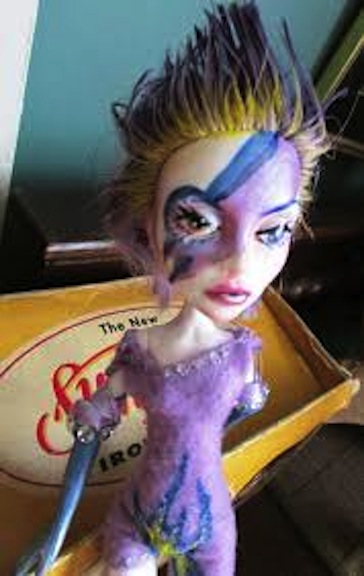
Avril E Jean converted this Monster High doll into a Bowie lookalike. The “Space Oddity” songwriter reaches across the universe.
David Bowie recorded his song and even shot a very primitive film that chronicled his character’s dilemma. This was an eon before MTV and its reliance on videos to make an artist and break a hit. Bowie, who initially aspired to be a West End musical-comedy star, was perfect in front of the camera. He willingly made these short-form movies — the length of his songs — so they could be played on television dance programs. It was genius. By making mini spectacles, he could appear on multiple TV shows, in multiple countries, all at the same time. In his own unique way, Bowie was playing with the space-time continuum. He figured out a way to be in several places at the same time.
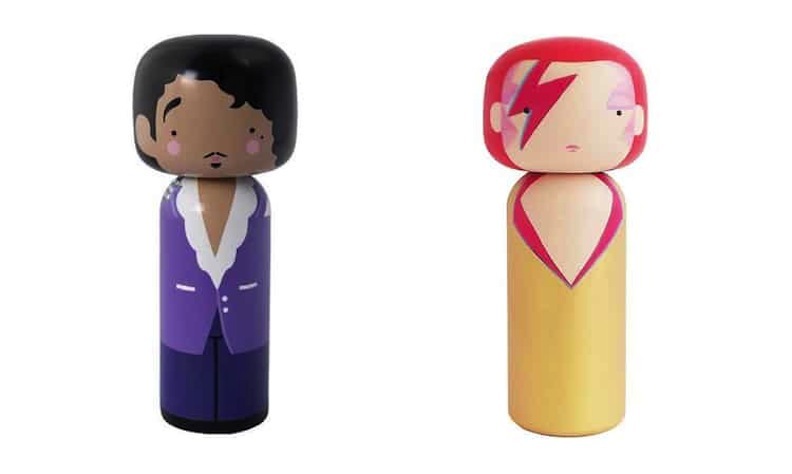
Perhaps they are jamming in rock-n-roll heaven? Sketch Inc created these Kokeshi Dolls to celebrate Prince and David Bowie.
His connection to space travel and self-examination has gone beyond just philosophy. In 2013, Canadian astronaut Chris Hadfield performed the song aboard the International Space Station. Hadfield’s delivery, which was filmed, became the first music video ever shot in space. Beyond inspiring other glam-rock musicians and avant-garde personalities, Bowie became, in essence, the first universal rock star. David Bowie’s song “Space Oddity” went beyond the earth and reached past the stars. That’s quite an accomplishment for a boy born in Brixton, London, in 1947.
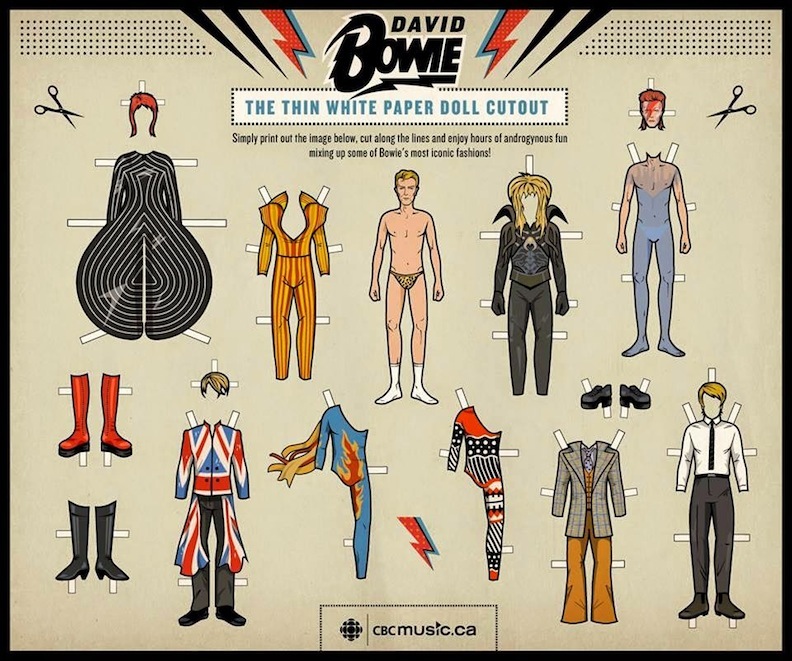
A Thin White Paper Doll collection by Heather Collett for the Canadian Broadcasting Corporation/Music Division.
Because of his always-changing, ever-shifting appearance, Bowie is the ideal subject for doll artists. His chameleon-like ability to be both an outlandish outsider and an impressive insider is legendary. David Bowie could look like “The Man Who Fell to Earth” and “The Man Who Sold the World.” That’s not just a talent. Nope, that is some kind of divine gift. He had the rare ability to empathize with both astronaut and alien, earth man and extraterrestrial being. David Bowie was Ziggy Stardust and the Thin White Duke. He could not be contained in any narrow box.
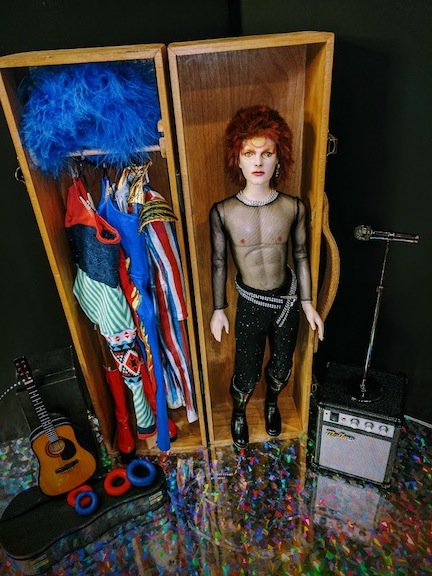
Dolls by Dell meticulously made this trunk set of Bowie and his costume choices.
Constantly challenging and re-inventing himself, Bowie’s legacy continues to influence artists, who salute and emulate him. Plus, it’s not just singers, songwriters, and performers that honor David Bowie. Doll artists are always in the mix, making effigies of him in all of his costumed glory. And the U.S. space program has jumped onto the rocket-ship bandwagon connected to Bowie and his “Space Oddity” composition. On July 20, at the Kennedy Center, NASA is hosting an event that will debut a brand-new video for the “Space Oddity” opus.

A fabulous salute to David Bowie’s shape-shifting ways! Nebula Art sells repaint/re-imagined dolls on Etsy.
The Kennedy Center festivities are commemorating both the 50th anniversary of the Apollo 11 lunar landing and the debut of Bowie’s epic song. The newly minted video is a combination of footage from Bowie’s storied career. Filmmakers taped some in 1997 at his 50th birthday concert at Madison Square Garden and in 1990 during the Sound & Vision tour. David Bowie will be applauded and lauded that night. His connection to the space mission will be front and center.
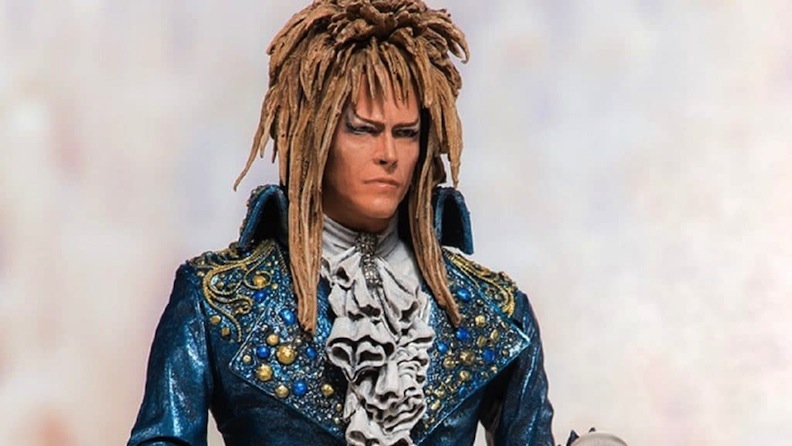
David Bowie was always a film fan, and made his mark in several movie roles. Shown here, McFarlane Toys’ Goblin King doll.
Additionally, and this would make David Bowie very happy, a new audio mix of “Space Oddity” will be released July 12, a day after the original’s anniversary. It will be part of a 50th-anniversary double 7-inch box set. All of these new developments are getting a lot of play and perking up interest.

Three geniuses at work: George Lucas, David Bowie, and Jim Henson, behind the scenes of “Labyrinth.” (Courtesy of LucasFilms/Henson Productions)
Follow the latest news and celebrations on Bowie’s brand-new hashtag: #SpaceOddity50.






